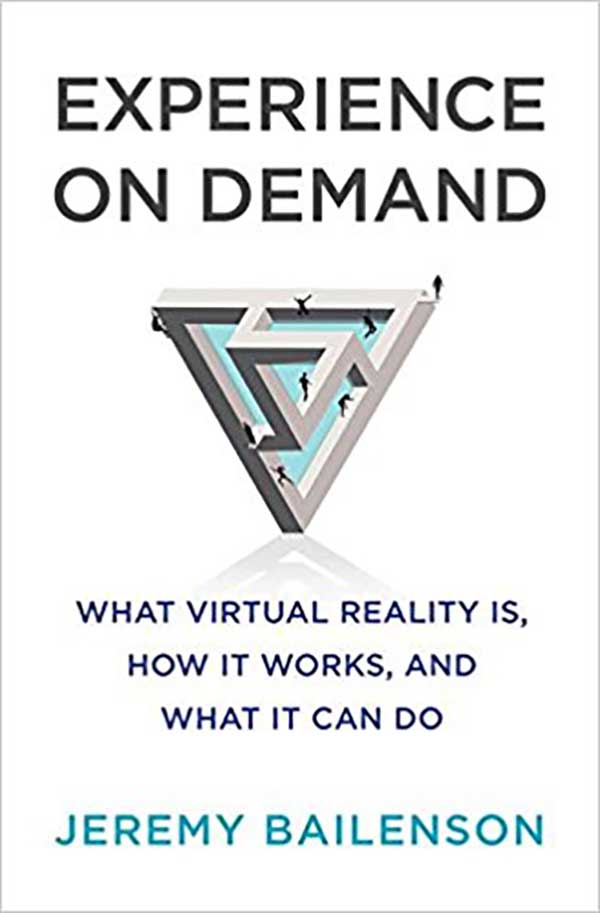On the morning of September 11, 2001, a 26-year-old woman stopped by a drugstore on the way to work at her office near the World Trade Center. When she left the store, she stood with a crowd on the street, looking up, transfixed by the smoke pouring out of a building. Then she saw the second plane hit the South Tower.

BOOK REVIEW — “Experience on Demand: What Virtual Reality Is, How It Works, and What It Can Do,” by Jeremy Bailenson (W.W. Norton, 277 pages).
Nearly 3,000 people died in the 9/11 attacks, but there was a psychological toll as well: long after that day, at least 10,000 firefighters, police officers, and onlookers in NYC were estimated to suffer from post-traumatic stress disorder (PTSD).
This woman was one of them. For months, she was tormented by the horrific images she’d seen. Traditional behavioral therapy, in which she was prompted to recall her experience of 9/11, did not seem to be helping.
Enter virtual reality. JoAnn Difede, director of the Program for Anxiety and Traumatic Stress Studies at Weill Cornell Medical College in New York City, realized that VR might enable the woman to become more emotionally engaged in recalling her memories from that fateful day. Using news footage and interviews, Difede and Hunter Hoffman, director of the VR Analgesia Research Center at the University of Washington, developed a virtual world that modeled the sights and sounds of lower Manhattan at the time of the attacks.
Strapped into VR headgear, the woman experienced a simulation of what it was like to be in lower Manhattan on September 11, 2001. After six sessions, the psychologists reported that the patient (whose identity they withheld) experienced reductions of 83 percent in symptoms of depression and 90 percent in symptoms of PTSD.
In his new book “Experience on Demand,” Jeremy Bailenson, founding director of Stanford University’s Virtual Human Interaction Lab, uses case studies like this to make a convincing case for the vast potential of VR to reshape everything from education to empathy to environmental conservation.
Bailenson is not the most detached observer. A VR pioneer whose involvement in the medium goes back nearly two decades, he is co-founder and “chief visionary” of STRIVR, a VR training company with clients including Walmart and the NFL. (The Arizona Cardinals were one of several NFL clients in 2015 and went on to a 13-3 record and a divisional title.) But it’s hard to argue with his overriding point: the interactive, 360-degree experience of VR gives it intrinsic advantages over traditional training methods, including video. “But as absorbing as books or video games or television are,” he writes, “in their immersive effects they pale next to virtual reality.”
The rise of VR in recent years — the global market has been projected to grow to more than $60 billion by 2022 — can be attributed to “a perfect storm of technological advancements, economic forces, and the bold actions of a few entrepreneurs,” Bailenson writes. Facebook’s acquisition of the VR company Oculus in 2014 was a major turning point, bringing new attention to the technology and promising to one day merge virtual and social media realities.
Still, one of the goals of Bailenson’s Stanford lab is to explore how VR can be used for human benefit, and “Experience on Demand” illustrates many of these applications. Perhaps the most intriguing is its use as what VR advocates call an “empathy machine.” Because VR feels so real, users come startlingly close to experiencing the world through someone else’s senses. A VR documentary called “Clouds Over Sidra,” co-created by artist and filmmaker Chris Milk with the support of Samsung and the United Nations, is the story of a 12-year-old girl inside a refugee camp sheltering 80,000 Syrians (population estimates vary). Just eight and a half minutes long, it had a profound impact on viewers: The United Nations reported that twice as many people donated after the experience of “Clouds Over Sidra” and two other VR documentaries.
As with any emerging technology, ethical questions about its use should be considered seriously before its widespread adoption. This rarely happens, and we often learn lessons after the fact. When the iPhone was introduced over a decade ago, few people foresaw the addictive potential of smartphones, to say nothing of physical effects like spine damage. As the VR pioneer Jaron Lanier has warned, the medium raises its own host of questions. Will it be used to help wealthy corporations get richer? With its power to immerse humans in alternate realities, how can it be used to manipulate others? Or spread propaganda?
Bailenson acknowledges that VR is “an entirely new medium, with its own unique characteristics and psychological effects, and it will utterly change how we interact with the (real) world around us, and with other people.” He warns that “the inevitable widespread adoption of VR poses unique opportunities and dangers.” But “Experience on Demand” is mainly about the opportunities. Before we get swept up by its potential, we ought to think clearly about the dangers.
Hope Reese is a writer and editor in Louisville, Kentucky. Her writing has appeared in Undark, The Atlantic, The Boston Globe, The Chicago Tribune, Playboy, Vox, and other publications.











Comments are automatically closed one year after article publication. Archived comments are below.
It is such interesting times now that much of the first hype is gone and we see the true potential and the downfalls of this new technology.. As the case of the first films patterns can be seen. We have taken the experience from Clouds from Sidra and harvested the fruits in the first environmental VR-series on global warming: http://www.biospherevr.com. The first films on Kiribati are out now. Go to http://www.inceptionvr.com to see My Drowning Island to get a feeling of the potential of this new technology.